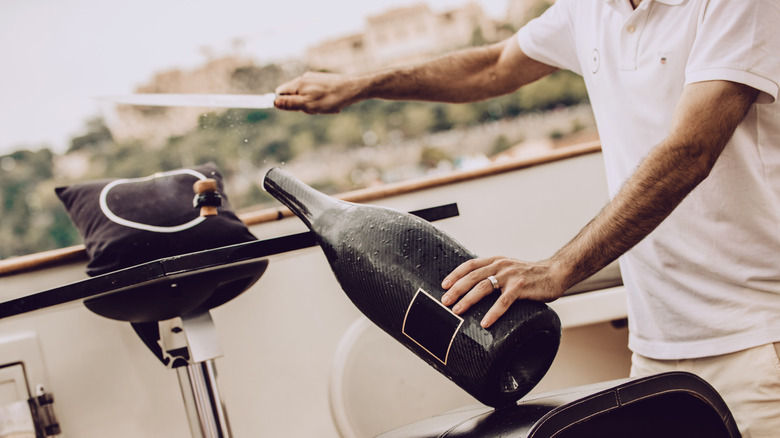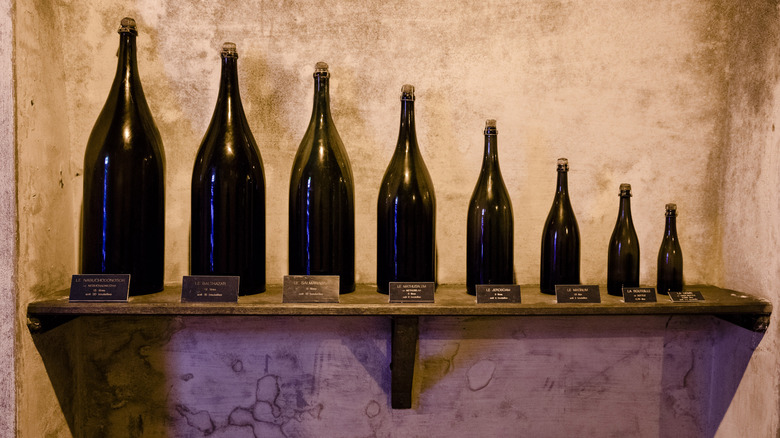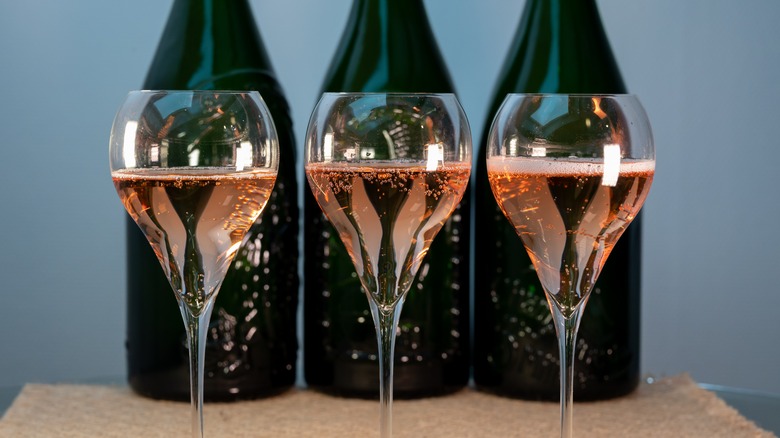Why It Always Pays To Buy Magnum Champagne
No wine is available to customers in as many different bottle sizes as Champagne. You can buy the effervescent French sipper as a split (a small single serving bottle), in a half-size or standard 750-milliliter bottle, or in larger formats featuring a bewildering array of names like Balthazar and Nebuchadnezzar. For the uninitiated, these two preposterously large bottles contain the equivalent of 16 and 20 regularly-sized Champagne bottles respectively.
Did we mention the magnum? Yet another Champagne sizing option, this double-sized bottle boasts 1.5 liters and is perhaps the best bargain of them all. You won't have to purchase a wine cellar big enough to accommodate a Nebuchadnezzar, and you'll have a Champagne bottle that will age better in a cellar, and stay fresh longer after opening than a regularly-sized offering. Additionally, its bigger size makes it a perfect choice for the festive occasions with which Champagne is indelibly associated. "One of my favorite things is to arrive at a party with a magnum of Champagne," notes Victoria James, Beverage Director for Gracious Hospitality Management, via Town and Country. "It's not that much more expensive than a regular-size bottle and it looks so cool."
Why magnums of Champagne age better and stay fresh longer
It's no secret where Champagne gets its characteristic fizz. Bubbles result from carbon dioxide, which is created during a secondary in-bottle fermentation. Over time, however, the levels of carbon dioxide in Champagne will slowly decrease due to the cork stopper. Cork is impermeable to wine but can be permeated by gases, albeit at a very slow rate. However, carbon dioxide doesn't escape all Champagne bottle types equally. A magnum of Champagne, for example, has more than twice the predicted shelf life of a standard-sized bottle (82 years as opposed to 40). Larger sizes have an even longer life span, meaning they'll continue to remain bubbly when opened decades or even centuries after they were initially bottled.
Magnums actually last longer after the bottle's cork has been popped as well. On average, Champagne bottles retain their effervescence for three to five days after opening, assuming they're restoppered and stored at a properly chill temperature. However, magnums retain more carbon dioxide in the bottle even after several glasses have been poured. Thus, they continue to exhibit a sparkling effervescence, even as regular-sized bottles have begun to go flat.
Why magnums are perfect for parties
Champagne has been synonymous with celebrations since the 18th century and remains a favorite for not just New Year's Eve but parties and get-togethers of all types. Which is to say, social situations in which there are likely to be a lot of people present. So, which would you prefer for a party, a regular-sized bottle that pours six glasses or a magnum that pours twelve?
The answer, of course, is the magnum. It holds more Champagne, its impressive size makes it a favorite for party photos, and it's not as expensive as you might think. You're paying for the equivalent of two bottles conveniently packaged as one. Occasionally, yes, magnums will have prices more than twice that of standard bottles, but that's because Champagne producers often prefer magnums to showcase their best wines.
Why? Because Champagne seems to age better in magnums than in any other bottle size. Yes, larger formats have been shown to have longer shelf lives, but they don't age as well in terms of the wine's power and complexity. "The magnum bottle is the best bottle for Champagne," confirms Vitalie Taittinger of the eponymous Champagne Taittinger in VinePair. "That's where you have the best ratio between air and wine and where the aging potential will be at its best." So, if you want not just more Champagne but better Champagne, it pays to buy magnums.



